| CONTROLLING
THE FELINE ESTROUS CYCLE

 403 403
Induction of Ovulation
- Ovulation can be induced by vaginal stimulation
with a glass rod, thermometer, or Concannon even adapted an electric
toothbrush! You must give multiple stimulations at least 2 hours
apart to induce a sufficient LH peak. Also, listen for the 'aftercry'
to ensure complete stimulation.
- A specific device marketed by Globanimal called
the 'Ovulator' is marketed as an instrument to induce ovulation.
- This company was trying to enforce a patent on
ovulation induction via vaginal stimulation. The web site no longer
works, and I have not tried to call them.
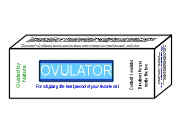
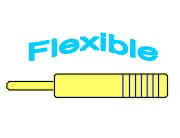
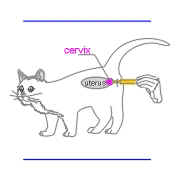
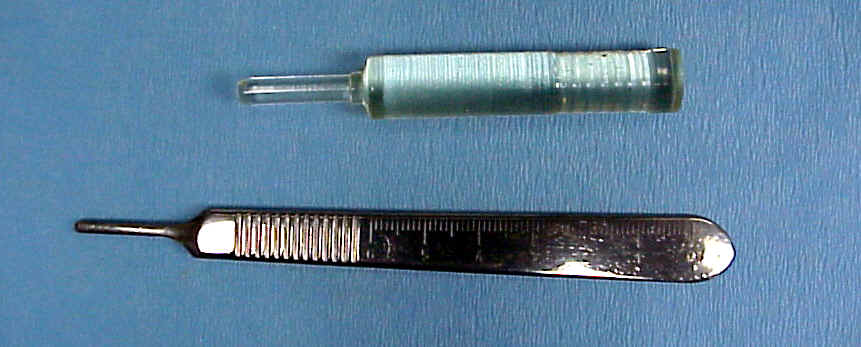

Click here to view a glass rod being used to induce
ovulation.
Right click on the frame to start.

Click here to view "The Toothbrush"
Right click on the frame to start.
- Ovulation can also be induced with exogenous
hormones.
- Administration of GnRH or LH after mating can be
used to increase the likelihood of ovulation. Both stimulate
ovulation by bypassing the vaginal/hypothalamic neural pathway.
GnRH
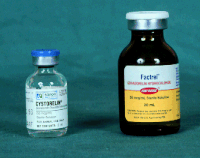
- According to one report, administration of 25 ug of
GnRH on the second day of estrus resulted in all mature follicles
present ovulating in all queens treated.
- Unlike hCG, GnRH administered in
conjunction with natural mating did not enhance ovulation.
Human chorionic gonadotrophin
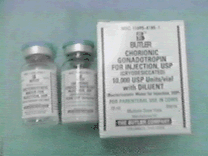
- Human chorionic gonadotrophin (hCG, Follutein,
Solvay Veterinary Inc., Princeton, NJ) has LH-like activity and can
be used as well as GnRH to induce ovulation.
- The results of two
reports suggest that a dose of 500 IU hCG on day 1 or days 1 and 2
of estrus achieved maximal ovulation rates.
- With lower doses, all
queens ovulated but ovulation rates per queen were less than 100%.
- hCG, administered at a dose of 250 IU on days 2 and 3 of estrus, and
coupled with mating three times per day at three hour intervals for
the first three days of estrus resulted in a doubling in the number
of corpora lutea formed.
- Unlike hCG, GnRH administered in
conjunction with natural mating did not enhance ovulation.
- hCG
administration may be useful in cases where the male has a low
libido and where a sufficient number of copulatory stimuli are not
achieved.
Induction of Estrus
- Estrus can be induced in the queen using follicle
stimulating hormone (FSH,FSH-P, Schering Corp., Kenilworth, NJ)7,22
or pregnant mare serum gonadotrophin (PMSG, eCG).
P.G. 600
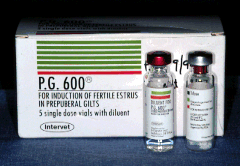
- Currently, PMSG (eCG) is commercially available in
the United States only in combination with hCG (P.G.600 Intervet
America Inc., Millsboro, DE). The effect of using hCG combined with
PMSG in an estrus induction scheme is unknown.
FSH
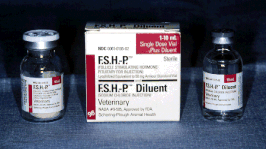
- The most successful protocol for induction of
estrus using currently available products administers 2.0 mg FSH IM
daily until estrus, but for not more than 5 days.
- Using this protocol, normal fertility was observed
in mated queens after estrus induction.
- Prolonged administration of FSH resulted in
follicular ovarian cysts which subsequently failed to rupture.
- Although they stimulated mature follicular
development, higher doses of FSH given as a single injection,
resulted in inconsistent sexual receptivity.
- Some queens, especially those under 1 year of age,
appear to be sensitive to ovarian hyperstimulation by exogenous
gonadotrophins.
- Queens experiencing an induced estrus may have an
increased number of both unovulated follicles and corpora lutea than
queens having a natural estrus.
Estrus Prevention or Suppression
 447-450 447-450
- Practitioners are at times asked to prevent or
suppress estrus in the queen.
- No approved drugs exist for this purpose.
- Cases of pyometra and cystic endometrial
hyperplasia associated with the use of progestogens in queens have
been reported. These side effects however, are not as common in
queens as they are in bitches.
Ovaban
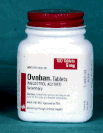
- Megestrol acetate, (Ovaban, Schering Corp.,
Kenilworth, NJ) though not approved for use in cats, has been used
for both estrus prevention and suppression. When begun during
seasonal anestrus, the administration of 2.5 mg/wk for up to 18
months.
- During the breeding season, begin treatment during
interestrus: 2.5 mg daily per os, can be given for up to 60 days
prevented a return to estrus. During the breeding season, 2.5 mg
given daily beginning during the interestrous interval for up to 60
days similarly delayed a return to estrus.
- When suppression of estrus is desired, a dosage of
5 mg daily for 3 days or until signs of estrus ceases should be
given. In this case, therapy is continued at a dose of 5 mg/week for
10 weeks or 2.5 mg/day for 60 days.
- The return of estrus was successfully delayed
during treatment and for 1 to 3 months after cessation of treatment.
- Other than weight gain, no serious side effects of
megestrol acetate were observed.
- More recently, significant adrenal cortical
suppression has been reported with the use of megestrol acetate.
- The queen should be allowed to have a normal estrus
without hormonal manipulation before retreatment.
Cheque
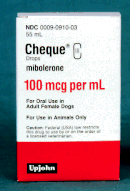
- Mibolerone, an androgenic steroid, is effective in
preventing estrus in queens. Serious side effects, however, preclude
its use in cats. Possibly fatal hepatic disease; changes in thyroid
function, serum cholesterol, thyroid histology and weight; and
slight masculinization noted by clitoral hypertrophy and thickening
of the cervical dermis were observed.
- Not available at this time.
Delmadinone acetate
- Although not currently available in the U.S.,
delmadinone acetate (DMA) offers promise for estrus control in the
queen.
- It was found to be safe and effective when
administered for up to 36 months.
- For estrus prevention, DMA can be administered
orally once a week or injected subcutaneously every 6 months.
- For estrus suppression, DMA is administered orally
once daily for 6 days or in-jected SC once or twice in a 24 hour
period.
- No short or long term side effects were noted with
use of DMA in cats.
Ovariohysterectomy
- Permanent estrus prevention, of course, is best
achieved by ovariohysterectomy.
- No undesirable side effects, other than possible
weight gain if fed ad libitum, have been associated with
ovariohysterectomy in queens.
- Ovariohysterectomy may be
performed on prepubertal kittens as young as 7 weeks of age.
- At this
age, the procedure is relatively simple and recovery is rapid
compared to older animals.
- No adverse signs have been seen when compared
to performing gonadectomies at an older age.
- Neutering male cats this age
results in no smaller penis than in toms neutered at an older
age.
|

